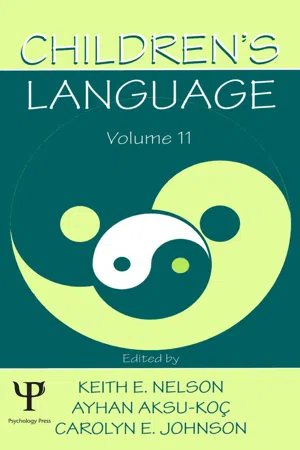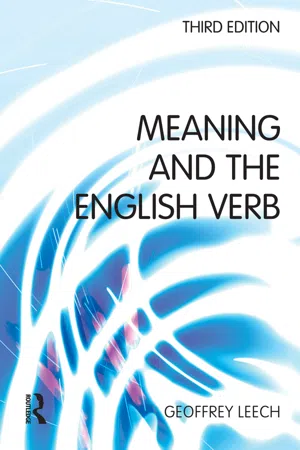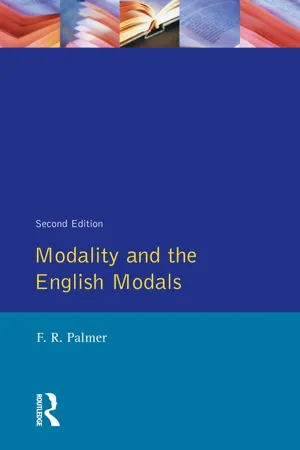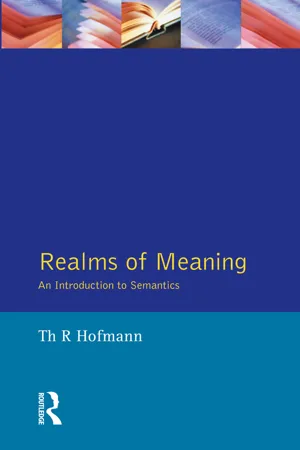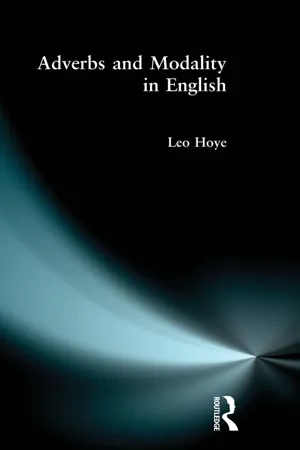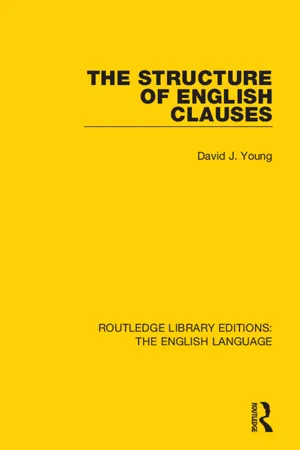Languages & Linguistics
Modal Verbs
Modal verbs are a category of auxiliary verbs that express modality, indicating the speaker's attitude towards the action or state expressed by the main verb. They convey notions such as possibility, necessity, ability, and permission. Examples of modal verbs include "can," "could," "may," "might," "must," "shall," "should," "will," and "would." These verbs are used to modify the meaning of the main verb in a sentence.
Written by Perlego with AI-assistance
11 Key excerpts on "Modal Verbs"
- eBook - ePub
- Michael Toolan(Author)
- 2014(Publication Date)
- Routledge(Publisher)
Billings is in Montana can be qualified by formulations which disclose some of the speaker’s less-than-total commitment to the truth of the statement, or which disclose some of the speaker’s wishes or attitude concerning the statement and its elements. The most grammatically established way of adding such qualifications, such modality-expressions, is by using certain of the modal auxiliaries:Billings must be in Montana. (it’s certain that)If the garage is empty and the house lights are off, he must be away from home. (it quasi-logically follows that)The Sonics must win tonight. (it’s crucial, vital that they win [NB , not ‘it’s certain’])Here, immediately, is a first complication: a modal verb like must has at least two rather different senses: certainty and obligation.Time Out: what are Modal Verbs?Modal Verbs, also known as modal auxiliaries, are a small set of verbs which can appear just to the left of a ‘main’ or ‘content’ verbal word. The list includes can, could, may, might, must, should, will, would, ought to, and a very few others. Notice that this list does not include the verbs have and be, which are virtually the only other verbs that regularly accompany a main verb by appearing to the left of it. In fact, the English verbal construction can be thought of, in a simplified picture, as comprising three parts:As the name auxiliary suggests, modal auxiliaries support and modify the main verb, particularly with meanings to do with ability, permission, obligation, and so on.Other versatile modals include may, can, should, ought to and might; for example, should sometimes conveys obligation – You really should see a doctor – and on other occasions conveys probability – They should have reached their hotel by now - eBook - ePub
- Bas Aarts, April McMahon, Lars Hinrichs, Bas Aarts, April McMahon, Lars Hinrichs(Authors)
- 2020(Publication Date)
- Wiley-Blackwell(Publisher)
It is perhaps due to the very large range of forms and meanings involved once the two categories are united that they tend to be dealt with separately. In everyday practice, modality in English is most commonly linked with modal auxiliaries, given the important role, noted above, played by modals in the expression of modality in English. Accordingly in the next section, we will list the formal characteristics of English modal auxiliaries before we go on to look Section 12.4 at the meanings that they can express and at ways of categorizing modality in English, focusing on what Huddleston calls analytic mood. 12.3 Analytic Mood: Formal Properties of Modal Auxiliaries Traditionally, a distinction is made between central modals (can, could, may, might, shall, should, will, would, must) and peripheral or marginal modals (dare, need, ought). In addition, we find a group of verbs referred to as semi‐modals, quasi‐modals, emergent modals, or periphrastic modals. This somewhat open‐ended category includes have to, need to, have got to (gotta), be able to, be going to, but can also include a variety of other verbs such as be supposed to, be about to, be bound to, want to (wanna), and had better. The central modals have all the “NICE” properties that are criterial to the classification of a form as an auxiliary verb (cf., e.g., Palmer 1974, pp. 18–25). That is, they have a negative form consisting of the auxiliary followed by not, they can precede the subject in subject–verb inversion (e.g., in interrogatives), they can occur in “code,” that is, they can be used instead of a full lexical verb which has occurred in the context (e.g., She will help and so will I), and they can be used in emphatic affirmation (She probably won’t help, but she MIGHT (do)). This means that unlike lexical verbs they do not require the use of do in such contexts - eBook - ePub
- Janice Fon, Janice Fon(Authors)
- 2019(Publication Date)
- De Gruyter Mouton(Publisher)
7 The first type includes languages that express situational possibility with verbal affixes. The second type uses verbal constructions including auxiliary and serial verb construction, and the third group uses other kinds of markers. Among the 234 languages surveyed in van der Auwera and Amman (2013), the second type is the most frequent, while the third type is the least. The strategy to mark epistemic possibility is also divided into the three types, although the most dominant type is the third type. English and Chinese belong to the second type, while Japanese belongs the first type. The verbal constructions that express possibility in English and Chinese are mainly studied in the field of modality, while the potential suffixes in Japanese have to do with voice. As is commonly known, modality and voice are different fields of linguistics; one is a semantic category, and the other concerns grammatical relations. Although the study of each field has developed in its own way, little attention has been paid to their mutual relationship (except Narrog (2010)). This study tries to seek a way to integrate the two categories through a semantic analysis of possibility and its related meanings.1.2Possibility in English, Chinese, and Japanese
In English and Chinese, as well as many languages of the Indo-European family especially, possibility is an important concept in defining modality. Modality, which is often stated to express a speaker’s (subjective) attitudes and opinion, has plenty of definitions presented in the literature. Among the huge number of studies on modality, van der Auwera and Plungian (1998: 80) define modality as “semantic domains that involve possibility and necessity as paradigmatic variants”. They classify modality into four types as presented in Table 1 . 8 Although this definition of modality is rather restricted, it is useful to show the polysemy of modal auxiliaries in English and Chinese.Table 1: Modality type (extracted from van der Auwera and Plungian (1998: 82)).1.2.1Expressions of possibility in English
The English auxiliary Can was originally derived from the Old English verb cunnan which means ‘know how to’ (Goossens 1992). The meaning of this mental ability has extended to express physical ability and is further generalized to the use of ability in general. Participant-internal possibility including ability refers to a kind of possibility internal to a participant engaged in the state of affairs, as in (2).(2) I can lift this stone.Participant-external possibility, which is also called “situational possibility”, refers to circumstances that are external to the participant and make the state of affairs possible, as in (3). Deontic possibility is a subdomain of participant-external possibility, in which case the enabling or compelling circumstances are some person(s) or some social or ethical norm(s) (van der Auwera and Plungian 1998: 81). Permission expressed by May in (4a) is an example. May was originally derived from the Old English verb m æg , which means ‘have power to’. It started from physical ability and went through a similar development as Can - eBook - ePub
Children's Language
Volume 11: Interactional Contributions To Language Development
- Keith E. Nelson, Ayhan Aksu-Ko‡(Authors)
- 2005(Publication Date)
- Routledge(Publisher)
A Developmental Perspective on Modal Verb Use by French-Speaking ChildrenCLAUDINE DAY Université de Paris 5, FranceLanguage researchers have long studied the representative function of language, that is, its use to describe the facts and phenomena of the world. Many valuable analyses investigating the formal aspects of linguistic systems show that phonological, morphological, and syntactic regularities are inadequate for clarifying the complexity of language activity. Recent developments in functional approaches to language and progress in interactionist or pragmatic research have put new emphasis on communicative function. Language use, then, may be considered as a form of social conduct, and the meaning of linguistic expressions as built within the interpersonal dimension. This is a dynamic process achieved by the joint constructive activity of those taking part in communicative interaction. Advances in linguistic theory have made possible not only an account of the plurifunctionality of linguistic terms but also of their polysemy and the ambiguities thus generated. This is an opportune entry into the study of meaning.An important notional category which lies at the interface of meaning and use is modality. In addition to referential and predicative operations, using language involves modalization, which consists of imposing a modal value on the sentence. Like some other aspects of language, modality is difficult to define because its expression involves ambiguity. Nevertheless, different definitions converge on a set of core properties characterizing this category. First, modality involves the qualification of predications either as pure and simple facts, or as suppositions, wishes, suspicions, and so forth. Modality is then expressed by the indicative mood implying certainty or by the conditional mood indicating uncertainty or contingency. Second, expression of modality involves a kind of commitment by the speaker to the truth or obligation entailed in a sentence. This is expressed by sentences with grammatical structures such as the declarative, the interrogative, or the imperative, which inform the addressee about the illocutionary force of the modal utterance. And, finally, modality is involved in the expression of statements, wishes, questions, commands, protests, and so forth, which characterize relationships between speakers. That is, modality refers to the pragmatic dimension as well. - eBook - ePub
The Grammar of Autobiography
A Developmental Account
- Jean Quigley(Author)
- 2000(Publication Date)
- Psychology Press(Publisher)
Brazil’s (1995) discussion of the modals in terms of a linear grammar (i.e., a purpose-driven grammar rather than a sentence-oriented one) suits our purposes very well. The meanings of words and expressions do not derive from a set of relations that exist permanently in the semantic system of which the word is part. Instead, the relations among items is a function of the way speakers use and understand them as having a “this-not-something-else” value that is valid for the particular here-and-now circumstances of their communication. The available set of choices open to a speaker at any given point makes up the “existential paradigm” (p. 249).Within this framework, Brazil (1995) sets out the following criteria as the distinguishing features of the modal auxiliaries (pp. 113–115).- They select for time reference, relating probability time to utterance time rather than event or condition time (can/could, may/might, will/would, shall/should) and polarity (can/can’t, may/may not, will/won’t, shall/shan’t), an aspect that will prove crucial in this analysis.
- They select for sense, although the possible existential alternatives for a modal belong to a very restricted class, comprising mainly of other modals.
- Because their potential for selection is always related to the probability of some event or condition, they are communicatively deficient: progress toward target state is always via a non-fmite verbal element (V1). There is no occasion when it is appropriate to say “She can” without following it with a V1, for example, take.
- The V1 that follows them has base form (i.e., infinitive). Using a modal verb commits the speaker to producing a verbal element and also one with prospective implications, something that does not apply in a general way to other kinds of verb. The base form of V1 is used whenever independent choice is precluded in this way: “the verb must get what it wants” (Pinker, 1994, p. 121).
Brazil (1995) also discussed specific ways in which we use the modal auxiliaries. For example, the exploitation of differentiated time reference choice to make something more acceptable socially, many instances of which are contained in this corpora (Would it be possible? If you could give me a lift) or the use of shall and will for future with prominence (I will never forget that, really.). The main point we ought to take from his analysis is that “used speech exploits the here-and-now values of the linguistic items that speakers make use of” (p. 33), therefore, after Halliday (1973), that the nature of the grammar is, at least partly, due to the nature of the task. This method of analysis rules out an “after-the-event approach” that assumes that the object for analysis already exists in its entirety, just as events and stories do not exist fully formed prior to their telling. Rather, discourse is something that happens now, piece by piece, in time, with the language being assembled as the speaker goes along. Instead of the static concept of constituent structure, Brazil (1995) made use of the dynamic notion of a sequence of states. The focus is on the way people use words to create oppositions: “it is this temporary here-and-now opposition that provides the word with the value that the speaker intends and the listener understands the communicative value of any item is negotiated between participants as the discourse unfolds the this-not-that relationship” (p. 35). This sort of analysis has its earliest roots in speech act theory and pragmatics with its notions of illocutionary force and indirectness. Ultimately however, a standard speech act view proves inadequate “because it ignores the observation of language in use and therefore ignores the pervasive indeterminacy of much language” (Stubbs, 1985, p. 2). Stubbs pointed out that historically, speech act theory has been very ambivalent in its attitude toward naturally occurring language in use. Despite Austin’s (1962) formulation of the task at hand as the collection of explicit performative verbs as a guide to illocutionary force, Searle’s (1969, 1979) version led Lyons (1981) to suggest that the term language act would be more appropriate than speech act in order to emphasize the abstract decontextualized view of language as proposed by Searle (Lyons, 1981, p. 172 cited by Stubbs, 1985, p. 5).26 - eBook - ePub
- Geoffrey N. Leech(Author)
- 2014(Publication Date)
- Routledge(Publisher)
Chapter 5 The Primary Modal Auxiliaries114 six auxiliaries, Primary and (Secondary) Past. CAN : 115 A ‘possibility’, B ‘ability’, C ‘permission’. MAY : 116 A ‘possibility’, B ‘permission’, C quasi-subjunctive uses. MUST : 117 A ‘obligation’, B ‘requirement’, C ‘logical necessity’. HAVE TO : 118 A ‘obligation’, B ‘requirement’, C ‘logical necessity’. RELATIONS BETWEEN CAN , MAY , MUST AND HAVE TO : 119 permission, possibility, obligation, requirement and necessity; 120 inverseness; 121 may and can (= ‘possibility’); 122 may and can (= ‘permission’); 123 must and have to (= ‘obligation’ or ‘requirement’); 124 must and have to (= ‘logical necessity’). ROOT AND EPISTEMIC MODALITY : 125. WILL : 126 A ‘prediction/predictability’, B ‘intention’, C ‘willingness’, D ‘insistence’. SHALL : 127 A ‘prediction’, B ‘intention’, C ‘other volitional meanings’, D ‘rules and regulations’.114Many pages, chapters, books have been written about the modal auxiliary verbs in English. One thing that can make it difficult to account for the use of these words (called ‘modal auxiliaries’ or ‘modals’ for short) is that their meaning has both a logical (semantic) and a practical (pragmatic) element. We can talk about them in terms of such logical notions as ‘permission’ and ‘necessity’ but, this done, we still have to consider ways in which these notions become remoulded by the social and psychological influences of everyday communication between human beings: factors such as motivation, condescension, politeness, tact and irony. Condescension, for example, in the right context makes the can of You can go now (which in logical terms means no more than ‘permission’) into something approaching a command (see §115 C b - eBook - ePub
- F.R. Palmer(Author)
- 2014(Publication Date)
- Routledge(Publisher)
1.1.2 ). In practice, however, limits can be drawn. The modal auxiliaries are a clearly defined set, and only those other verbs that complete the semantic systems into which the modal auxiliaries fit will be added. But some arbitrary decisions are inevitable.The scope of this study will, then, be defined as follows:[i] There is no doubt about the central position of MAY , CAN and MUST . They are both formally modals and clear exponents of possibility and necessity.[ii] OUGHT TO and SHOULD are also formally modals, and can be shown to be concerned with a facet of necessity (see especially 6.4 ).[iii] SHALL and WILL are included because they are formally modals, and although they do not relate to possibility and necessity they have much in common semantically with other modals (see especially 4.4 for SHALL , 3.3 and 7.1 for WILL ). Even their use for future time reference has some relation to modality (see 1.1.6 , 7.6.1 , 7.6.2 ).[iv] DARE and NEED are only half within the modal system. A brief section is devoted to each (5.5 and 6.5 respectively), but NEED is also considered as the non-assertive counterpart to MUST (6.3.1 , 6.3.2 ).[v] USED TO will not be discussed, since it is outside the formal system, although it has many of the formal characteristics of a modal.[vi] Brief consideration will be given to IS TO (7.8 ) and to the more marginal HAD BETTER (4.7 ) and WOULD RATHER (7.9 ).[vii] There will be detailed discussion of BE BOUND TO (3.2.2 ). BE ABLE TO (5.2 ), HAVE TO/HAVE GOT TO (6.2 ) and BE GOING TO (7.3, 7.4 - eBook - ePub
Analyzing the Grammar of English
Third Edition
- Richard V. Teschner(Author)
- 2007(Publication Date)
- Georgetown University Press(Publisher)
Chapter 4Modals, Prepositional and Particle Verbs, Transitivity and Voice, and ConditionalityModals and Perimodals
Before this discussion begins, it should be recalled again that the nine Modal Verbs can/could/may/might/must/shall/should/will/would are auxiliaries. Nonmodals be/do/have are also auxiliaries. One of the topics we will discuss in this section is the formal and the functional differences between modal and nonmodal auxiliaries as well as between both of them together and the category known as lexical verbs (LVs)—the vast majority of all the verbs in the language—that are not auxiliaries at all. Mention will also be made of peri[phrastic]-modals, that is, verb phrases that behave like modals but only in part. Consider the following facts:a. Modals disallow do-insertion.Because they are auxiliaries, modals do not allow do -insertion. The contrasts below exemplify this.b. Modals do not inflect—they lack person, number, and tense. The following conjugation proves that modals do not inflect whereas LVs do: c. Modals lack past/present participles, so cannot form compound tenses. Proof of this is that the modal column contains only ungrammatical sentences:modal verb: no participles LVs: both participles *I have canned work hard. I have worked hard. *I can haved work hard. etc. You have worked hard. He has worked hard. *You have canned work hard. She has worked hard. *He has canned work hard. etc. We have worked hard. etc. You are working hard. He is working hard. She is working hard. We are working hard. etc. To express the meaning of can in the past tenses or in perfect tenses, one must use the semantically similar semi-auxiliary phrase be able to , thus:I am working hard. I have been able to work hard. I was able to work hard. I had been able to work hard. etc.d. Modals kill their infinitive complements’ to - eBook - ePub
Realms of Meaning
An Introduction to Semantics
- Thomas R. Hofmann(Author)
- 2015(Publication Date)
- Routledge(Publisher)
One simple but deceptive fact is that the first four of these modals have an alternative or ‘indirect’ form that is used in reporting what someone said or thought (or when talking about an impossible situation – as in the question following), as shown in the equivalences below. The other modals lack a special form for this, so either the same form is used or it must be replaced by a word that is not a modal.Q. These indirect forms are also used for the ‘counterfactual subjunctive’ that expresses doubt or non-belief of the situation described. What are the forms needed to put can, may, shall, will, must in non-factual frames such as ‘If you ___ come, everything would work out’ or ‘I wish that you ___ come’?1These ‘indirect’ forms used to be called ‘preterite’ or ‘past’, but that was deceptive. Other preterite forms in the language are freely used for past time events but these forms can be used that way only in a few specific uses. Except for could and some special cases, modal forms depict present possibilities, obligations, conclusions or whatever. As a result, these underused forms such as should, might have been put to new uses, and with other changes that have occurred there is no longer any simple way to describe the meanings of the English modals.In fact, many attempts have been made to find central or basic meanings for each modal that can explain their common and effortless use. Other studies end up with three or four meanings for each modal. Most recent work has tried to explain the variations of meaning for each modal on the pragmatic factors of Chapter 14 , but may not be helpful in deciding which meaning a modal has in a given context, or which one to use when. A useful description lies between these extremes, where we can find some system mixed with some evolutionary remnants.Having identified the ‘indirect’ forms used for reported speech and non-factual situations, we can put them aside to concentrate on the heart of the problem. A second step to simplify our study of modals is to recognize that some special idioms include modals, such as the following polite formulas seen in Chapter 5 - eBook - ePub
- Leo Hoye(Author)
- 2014(Publication Date)
- Routledge(Publisher)
The identification and description of modal—adverb expressions could usefully be incorporated in general works of language reference, and especially bilingual dictionaries targeted at the nonnative user. The entry for each individual modal would include details of its collocational possibilities and list its collocational range; such information would make a valuable contribution to a more precise description of the modal's meaning and how this is affected or modified by different types of adverbial collocate. For instance, it is only in combination with WELL that the modals MIGHT, MAY and COULD assume a new meaning and express a higher degree of likelihood than the unmodified forms. Likewise, certain adverbial combinations with MUST, involving such items as APPARENTLY or EVIDENTLY, introduce an evidential dimension into what is otherwise a purely judgemental epistemic system in English. There is significant potential for making dictionary entries more explicit by including the kind of syntagmatic information that the description of modal-adverb co-occurrence yields. The point is taken up by Nattinger and DeCarrico (1992: 182) who argue that lexicographical research will increasingly have to take account of the patterns of words that only analysis of large corpora can reveal:A thorough dictionary ... would not stop with collocations, but would select those that play particular functional roles in the language and further label them as lexical phrases. Such a dictionary would be a major resource for information about the language, for it would list not only the form and reference for particular collocations, it would also assign each its function....The implications for teaching are also significant. Syllabus design would need to move well beyond purely structural considerations and the selection and gradation of grammatical items on which so many foreign language programmes have traditionally been based. Contextual and functional information would also be included and related to the range of discourse functions - exchanging information, voicing attitudes and opinions, using directives - with which modal—adverb expressions are so clearly associated. With pedagogical needs firmly in view, modal—adverb collocations could be defined and effectively presented in teaching materials as 'basic units in strategies of oral and written discourse' (see Nattinger and DeCarrico 1992: 186). They enable the language user to implement strategies commensurate with his need to appear authoritative, uncommitted, vague or polite, and in ways that are always appropriate to and consistent with the particular context of communication. The kind of exercises proposed here are exemplificatory and programmatic, and gradually develop situations that increasingly require genuine communicative practice and rehearsal of the wide repertoire of modal expressions that are available to more experienced speakers.21 - eBook - ePub
- David Young(Author)
- 2015(Publication Date)
- Routledge(Publisher)
8 Modality 8.1 Modality: structureModality is the name of the system modal v. non-modal and is relevant to the grammar of clauses. A clause may be modal in various ways, as shown in 1 and 2:1Possibly he is ill 2He may be ill In 1 the modality is realized by means of a modal adjunct and in 2 by means of a verbal group with a modal auxiliary as operator. We shall be concentrating on modality realized in the second of these ways. In the following examples the verbal groups are outside the parentheses and the modal auxiliaries are in italics:3(He) will appear (on Saturday)4(The programme) may have seemed (under-rehearsed)5Can (they) come (in)?6(A worry) should not be thought (about throughout the whole of the waking hours)7(It) will start to discharge (electrons) (Appendix BI , 1. 18)8(You) ought to be (aware of this)9(The recreational facilities) must have been provided (by the Council)Modal auxiliaries are always initial in the verbal group and occur in finite verbal groups; in fact, they are always operators. When be and have occur as auxiliaries, they may be operators but are not necessarily so; for instance, they are not operators in the occurrences that are in italics in examples 10–12:10(They) must have been provided (by the Council)11(He) is being cautioned (by the police)12(You) may be leaving (early)Another word that occurs as auxiliary is do; this too, when it is an auxiliary, is always an operator, but it differs from the modal auxiliaries: do cannot be followed by another auxiliary, nor by be as main verb. In the following examples, do is contrasted with may, which is chosen as a typical modal.13aHe does speak quickly 13b*He does have spoken quickly 13c*He does be saving a lot of time 13d*He does be too proud 14aHe may speak quickly 14bHe may have spoken quickly 14cHe may be saving a lot of time 14dHe may be too proud Modal auxiliaries are the only type of verb that does not vary in form for concord with the subject. This is illustrated in Figure 30
Index pages curate the most relevant extracts from our library of academic textbooks. They’ve been created using an in-house natural language model (NLM), each adding context and meaning to key research topics.
Explore more topic indexes
Explore more topic indexes
1 of 6
Explore more topic indexes
1 of 4



